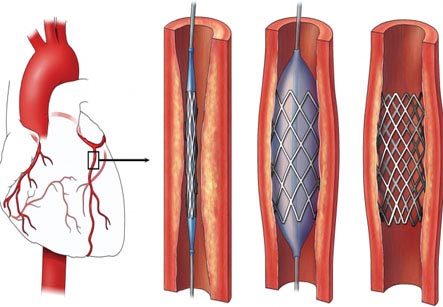Angioplasty
Introduction
Sometimes certain heart disease may lead to narrowing of the arteries that supply the muscles of the heart that make it pump blood. This narrowing may lead to lack of blood in the heart muscles and also a sudden deprivation of blood leading to a heart attack. Angioplasty is a non-surgical procedure that can be used to open blocked heart arteries. Stent placement is another option that can be done during angioplasty. This procedure is performed in a cardiac catheterization laboratory (or cath lab) by a specialized cardiologist and a team of cardiovascular nurses and technicians.
Surgical Technique
Before surgery the patient is given medication to relax. Area around the groin is shaved, cleaned and numbed with a local anesthetic agent. Then a thin plastic tube containing a tinner probe is inserted into a major artery in the thigh near the groin called the femoral artery. A long, narrow, hollow tube, called a catheter, is passed through the sheath and guided up the blood vessel to the arteries surrounding the heart.
Iran is among the top 10 countries in treating cardiovascular diseases, while it ranks first in the Middle East

Drugs to manage blood clots, pain and infection are given.
First small amounts of dye or radio-contrast material is injected through the catheter and an X ray is taken to see the level of blockade and position of the catheter tip. From the digital pictures of the contrast material, the doctors can tell whether the coronary arteries are narrowed and/or whether the heart valves are working correctly. The whole process lasts for around 1 to 3 hours.
Thereafter the intervention is preformed. Angioplasty may be of different types with balloon angioplasty, stent placement being the commonest types. Balloon angioplasty involves placement of a specially designed catheter with a small balloon tip is guided to the point of narrowing in the artery. Once in place within the artery, the balloon is inflated. This compress the fatty matter into the artery wall and stretch the artery open to increase blood flow to the heart.
Similarly stent placement involves placement of mesh like scaffold within the artery wall to keep it open and allow for blood flow. A balloon catheter, placed over a guide wire, is commonly used to insert the stent into the narrowed coronary artery. Once in the site of the procedure the baloon is inflated to expand the stent and keep it in place. The balloon is then deflated and removed while the stent stays in place permanently.
Follow up and post operative considerations
Once in place the stent allows the arterial wall to grow around it. This strengthens the stent and keeps the artery open. Patient may remain in the hospital for a day after the procedure to observe for complications. The patient needs to lay flat after the operation for at least six hours.
Pain, infection at the operative site and other complications may be seen. Sometimes blood clots may be dislodged to the brain or lungs leading to life threatening complications. Drugs to manage blood clots, pain and infection are given. Long term therapy include drugs to lower cholesterol and blood sugar (in diabetics). A healthy diet and regular exercise is also prescribed.
Other types of angioplasty include rotoblation where a corn-shaped, diamond-coated tiped catheter is inserted. The tip spins at high speed and breaks down the plaque that clogs the artery. This procedure is not used much these days.